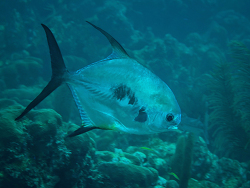Info
Trachinotus blochii (Lacepède, 1801)
Trachinotus blochii, also known as Shortnose mackerel or Snubnose pompano, can be found along the entire East African coast. From the Red Sea to Eritrea, south to Kenya and Mozambique to South Africa, east to Madagascar, Mauritius, Reunion and the Seychelles.
As a juvenile, they prefer sandy shorelines and bays, as a semi-adult specimens they are usually seen in small groups near reefs, very large adult specimens usually single.
In general, they are silver, usually paler ventrally. Large adult specimens often show a more orange tint. The head profile is very steep with a flattened mouth, the dorsal and anal fins are much larger (longer) than other "Pompanos" as they are also called.
The Snubnose pompano feed almost exclusively on other animals that live in sand, for example, all species of mollusks and other invertebrates with and without shell. Adult animals reach a size of up to 110 cm, for this reason they are not a fish for a "traditional" aquarium, however, be successfully maintained in some show aquariums.
Synonymised names
Caesiomorus blochii Lacepède, 1801 · unaccepted
Scomber falcatus Forsskål, 1775 · unaccepted (synonym)
Trachinotus blochi (Lacepède, 1801) · unaccepted (misspelling)
Trachinotus falcatus (Forsskål, 1775) · unaccepted
Trachinotus fuscus Cuvier, 1832 · unaccepted
Trachynotus blochi (Lacepède, 1801) · unaccepted (misspelling)
Trachynotus falcatus (Forsskål, 1775) · unaccepted
Trachinotus blochii, also known as Shortnose mackerel or Snubnose pompano, can be found along the entire East African coast. From the Red Sea to Eritrea, south to Kenya and Mozambique to South Africa, east to Madagascar, Mauritius, Reunion and the Seychelles.
As a juvenile, they prefer sandy shorelines and bays, as a semi-adult specimens they are usually seen in small groups near reefs, very large adult specimens usually single.
In general, they are silver, usually paler ventrally. Large adult specimens often show a more orange tint. The head profile is very steep with a flattened mouth, the dorsal and anal fins are much larger (longer) than other "Pompanos" as they are also called.
The Snubnose pompano feed almost exclusively on other animals that live in sand, for example, all species of mollusks and other invertebrates with and without shell. Adult animals reach a size of up to 110 cm, for this reason they are not a fish for a "traditional" aquarium, however, be successfully maintained in some show aquariums.
Synonymised names
Caesiomorus blochii Lacepède, 1801 · unaccepted
Scomber falcatus Forsskål, 1775 · unaccepted (synonym)
Trachinotus blochi (Lacepède, 1801) · unaccepted (misspelling)
Trachinotus falcatus (Forsskål, 1775) · unaccepted
Trachinotus fuscus Cuvier, 1832 · unaccepted
Trachynotus blochi (Lacepède, 1801) · unaccepted (misspelling)
Trachynotus falcatus (Forsskål, 1775) · unaccepted







 Scott & Jeanette Johnson, Kwajalein Unterwater
Scott & Jeanette Johnson, Kwajalein Unterwater



















